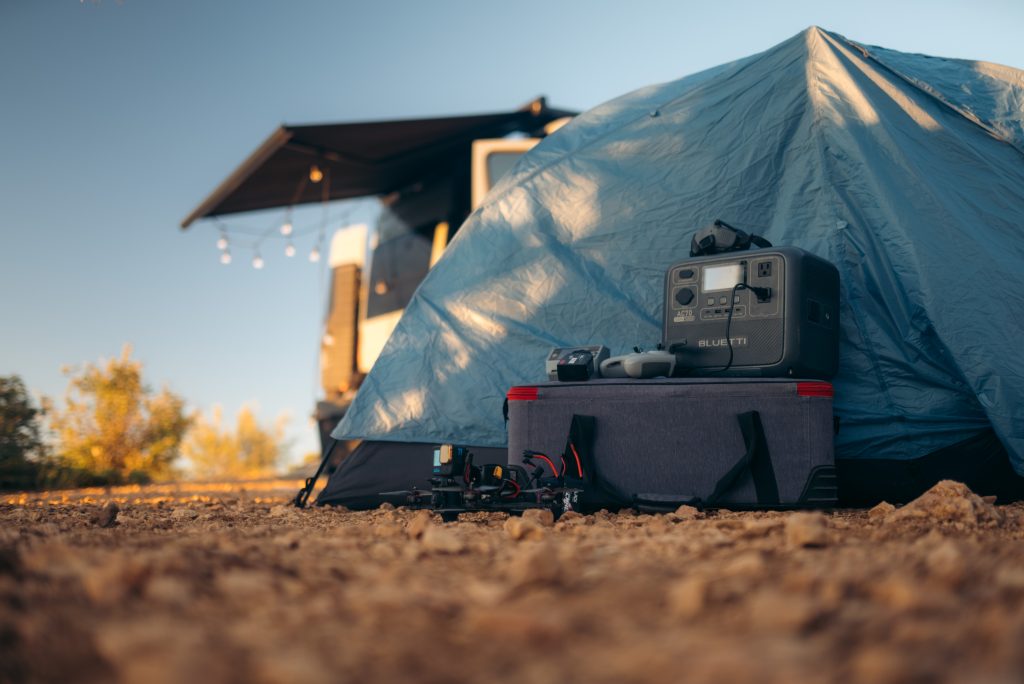Bluetti hasn’t been around for all that long – a few years now – but already they’ve made a bit of a splash with a variety of power solutions designed for all kinds of uses. Bluetti products are primarily battery-backed energy storage solutions, with a variety of applications – there’s units designed for camping, solar storage, home storage and more. There are other uses too – which we’ve explored in our AC70 review – such as long-term battery backup for critical home electronics.
So what is the Bluetti AC70?
Marketed as 1000W power station with a 768Wh capacity, the AC70 can provide steady 1kW power out, and can boost to 2kW for resistive loads only (think kettles, heaters, heated blankets, etc). It features a variety of connections, providing a pure sine-wave AC output (for sensitive electronics which need a nice clean power supply), as well as a variety of USB power sockets ( 2 x USB A and 2 x USB C) and a DC (cigarette lighter style) output also for use with accessories designed for use in a car.
Inside is a LiFePO4 battery which is rated for more than 3,000 charge cycles, and you can charge it a few different ways – it can charge at 950W from an AC supply, giving you an 80% charge level in around 45 minutes, and it can charge with up to 500W of solar input which will fully charge in 2 hours or so. There’s also a car charging cable which will plug into your car’s 12V socket so you can charge it while you’re driving, too.
Bear in mind the unit does make a little bit of noise – it has internal fans to provide cooling and keep everything happy. You can set the AC70 to charge more slowly, and thus generate less heat, and this negates the need for the fans to run making it near silent. If you turn on turbo charging – which can do a full charge in an hour and a half – you will get some fan noise.
With a 768Wh capacity, you can get a huge amount of energy out of this unit; depending on your load, you could run for hours off the built-in battery, and if your demands are a little higher, you can chain extra batteries to increase your capacity too.
What does the AC70 do for you?
We’ve opted to use the Bluetti AC70 as a super-charged home UPS to keep our media server, internet equipment and home WiFi controllers powered in the event of power interruption or a blackout. This load is around 200W, meaning that the AC70 can power this for 3.5-4.0 hours depending on fluctuating demand.
We’ve had – unfortunately – the opportunity to test this a couple of times while Ausgrid has done some work in our street, and the runtimes meet expectations; on one occasion, we reached around 4 hours runtime from the unit, and on the other occasion, we reached closer to 8 hours. This was because we recognised the need for a longer runtime, and shed some load, turning off gear which wasn’t essential so we could reduce the load down to 100W or so.
While not exactly marketed as a UPS, the Bluetti AC70 does function as one, switching from the utility power supply to the rectifier supply in as little as 20ms, which is enough to maintain power to sensitive electronics (read: computers) which tend to throw a fit if the power is interrupted for much longer than that.

Besides this functionality though, the AC70 is capable of quite a bit more. With optional extension batteries and solar charging kits, the AC70 can power your weekend off-grid adventures, allowing you to take the creature comforts with you (such as a kettle or a coffee machine), as well as keeping your daily essentials topped off (e.g. charging your mobile, laptop, camera, etc). With these (relatively) light power needs, the AC70 would easily last days rather than hours for some applications.
It’s convenient to carry, with a built-in handle to make it easy to move the 10kg of weight around. It’s not what you’d call light – LiFePo4 batteries are fairly solid – but it’s easy enough to move around… though you’d think carefully about taking it for a long hike. It’d be far more convenient to charge it up, pop it in the car, and drive it to your intended campsite.
For use around the home, of course, the weight isn’t really a consideration as you’re likely to pop the AC70 where it’s needed and just leave it there. This is what we’ve done – placing it in the hall cupboard where the IT gear lives – and now we barely hear or see it, or even know that it’s there.
Considerations
Do bear in mind the preferred operating ranges, though. If you’re putting or using the AC70 in a place with limited ventilation, you may reach the 40 degree upper limit relatively easy, especially over summer when things tend to get warm. At our place, where the hall cupboard usually sits about 10-15 degrees above ambient due to the heat generated by the electronics, we will need to be careful on warmer days when the temperature logger has shown it can get toasty warm in the cupboard. This won’t necessarily shut the AC70 off – thus dumping your electronics unexpectedly – but you can imagine it would degrade the efficiency and capacity of the unit. It would be prudent to keep an eye on the temperature if you’re putting the AC70 somewhere without much air.
Out and about, though, temperature isn’t likely to be a significant issue, as Bluetti claims the AC70 can run comfortably between 0 and 40 degrees when charging, and as low as -20 degrees when discharging. It will, of course, generate a bit of its own heat when it runs, which is a bit of a buffer if you’re in colder environments.
Monitoring
Monitoring the AC70 is fairly simple; there’s an easy to use LCD interface on the front of the unit that gives basic information about charge state, load, time remaining and so on, as well as alarms, and three simple buttons to operate – a master power switch, a DC out power switch and an AC out power switch. Be careful with these – if you turn off the AC output while you’ve got a load connected, you’ll immediately turn it off, so it might be prudent to keep it away from curious hands if you value your stuff staying turned on.
For more insight, the AC70 pairs with your compatible iPhone or Android smartphone so you can get stats via Bluetooth, and you can control the unit this way as well, letting you turn power on/off remotely (which might be handy if the battery lives in your car and you’re camping nearby and not wanting to get up).
Conclusion
Bluetti’s AC70 retails for $899 at the moment ,and there are various other packages available, including a 120W solar kit for $1,268, a 200W solar kit for $1,548, and a monster 350W solar kit for $1,998.
There are also options to connect to other Bluetti batteries – the $999 B80 battery (offering another 800 Wh of storage) can be connected using an optional Aviation to XT60 cable, B230/B300 batteries (offering 2000Wh and 3000Wh extra) can be connected using a couple of connector cables for an extra $1,799 to $2,499.
Unfortunately, like most things with Lithium components, off grid power like this isn’t exactly cheap, but it’s a question of what cost you’re prepared to accept to meet your particular needs. For a UPS, yes you can buy a cheapo UPS from your local electronics distributor for a couple of hundred dollars or so, but they generally are not designed to run for hours; you might get 10-15 minutes so you can safely shut down your equipment, rather than power it through a blackout.
For us, safe shutdown isn’t all that important, but longer run times and continuing to work during blackouts is far more important, making the cost of Bluetti’s AC70 neither here nor there.





this battery will be so good for people who wants to use the new Starlink Mini dish to get internet while camping